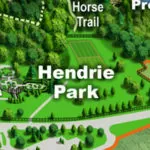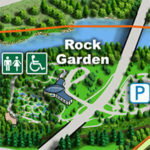| Membership | Price (+HST) |
|---|---|
| Single | $85/year |
| Single Plus | $120/year |
| Family | $130/year |
| Family Plus | $175/year |
| Contributing | $300/year |
| Supporting | $600/year |
| Sustaining | $1,000/year |
| Benefactor's Circle | $2,500/year |
| Director's Circle | $5,000/year |
| President's Circle | $10,000/year |
Cootes Paradise Trails
Established in 1927 for its significance as a migratory bird stopover, Cootes Paradise is RBG’s largest and most diverse sanctuary at over 600 hectares. The area features a 320-hectare river-mouth marsh, 16 creeks and 25 kilometres of shoreline. The surrounding forest is dominated by large oak trees while the marsh is part of a large scale Great Lakes restoration program.
-
18
km of trails
-
10
Lookouts
-
5
Boardwalks
-
12
Creek Crossings

See trail conditions below for any closures or interruptions.
Trail Conditions
27 kilometres of trail include packed earth, crushed stone, asphalt and boardwalks; some sections are steep and hilly. Trails are not plowed or sandy during the winter. During spring thaws and after rains, earthen trails become muddy. Please take appropriate caution.
Current interruptions and Closures:
- 2025 Controlled Burn Notice: Princess Point and the east end of the Anishinaabe trail will be temporarily closed for one day to facilitate a controlled burn. TENTATIVE DATE: Monday, April 14, 2025
There will be no access to Princess Point or the east end of the Anishinaabe waadiziwin Trail on the day of the burn.
Major Access Points
Princess Point
Princess Point is a natural gathering place and trail hub. It includes a canoe launch to Cootes Paradise Marsh and access for ice skating, as well as connections to six kilometres of nature trails and Hamilton’s Waterfront Trail. Princess Point is undergoing restoration to return it to its pre-European roots as an oak savannah.
Arboretum
The Arboretum is a hub leading to more than 10 kilometres of RBG trails, as well as many horticultural collections including lilacs, magnolias, flowering dogwoods and the Avenue of Trees. It is also home to RBG’s Nature Interpretive Centre and historical Rasberry House.
Paddle
Explore Cootes Paradise by canoe to get a glimpse of the astounding life that depends on the health of the marsh for its survival.
Trail Destinations
Cootes Paradise is home to lots of interesting trails and lookouts! Here are 5 key destinations marked by number on the pdf map.
1. Burial Grounds
Located on Burlington Heights along York Blvd., the area provides the best views of Cootes Paradise. A memorial marks this site’s historic connections — the War of 1812, immigrants who died arriving by ship in the 1840s and those who died in a cholera epidemic in 1854.
2. Westdale Ravine
Located on the south shore of Cootes Paradise, this deeply incised sand-plain ravine features a spring-fed creek, exposed glacial beach rocks and some of the tallest trees on the property. It is a forest-birding hotspot.
3. Anishinaabe waadiziwin
Native plants provide Indigenous peoples with almost all of life’s essentials. Starting in the Arboretum near the Nature Interpretive Centre, this new trail explores plants used by the Anishinaabe peoples, and their connections to culture, language, ecology and history.
4. Pine Point Lookout
Below the Lilac Dell and looking out towards Hickory Island, this is one of the few locations where White Pine dominates, evoking images of the forests that once covered the area.
5. The Fishway
Located at the outlet of Cootes Paradise Marsh, this seasonally operated structure blocks the entrance of more than 10,000 non-native carp annually, while ensuring the spring migration of native Lake Ontario fish to and from this critical spawning area.
6. Marsh Boardwalk/Spencer Creek Delta
The boardwalk provides an up-close look at one of the largest creek deltas on Lake Ontario. This area is favoured by migratory waterfowl and is the best place to view Bald Eagles. Rat Island is directly across the creek to the south of the platform.
Find Your Hike with Geotrail
Explore our Trails with an interactive map from Geotrail. View trail lengths, see lookouts, compare path elevation, and more.
Canada’s Biodiversity Hotspot
Royal Botanical Gardens’ 1,100 hectares is dominated by nature sanctuaries enveloping the western end of Lake Ontario. These form a Nodal Park within the Niagara Escarpment World Biosphere Region and the heart of the Cootes to Escarpment Ecopark System. With more than 750 native plant species, 277 types of migratory birds, 37 mammal species, 14 reptile species, 9 amphibian species and 68 species of Lake Ontario fish, the area is an important contributor to ecosystems that span international borders.
About Cootes Paradise
What’s in a Name?
The site is named after Captain Thomas Coote, a British army officer who enjoyed hunting the abundant waterfowl while on leave from his duties at Niagara in the 1780s. The community at the west end of the marsh was also named Cootes Paradise until the 1840s, at which time the name was changed to Dundas.
Early Residents
People have been drawn to Cootes Paradise for centuries. From AD 500 to 1000 this area was occupied by the Princess Point people, named after archaeological discoveries which indicated they were the first to bring agriculture to the region. Europeans arrived in the 1700s, with the first houses built on the north shore plateaus. One of these sites, Rasberry House, remains today.
Vegetation and Microclimate
Nestled between the Niagara Escarpment and Lake Ontario, the area’s flora is characteristic of the more southern deciduous forest region. Carolinian trees such as Sassafras, oaks and hickories dominate the North Shore, while northern species like Hemlock, Beech and White Cedar are found on the South Shore.
Habitat Restoration
At the inception of Project Paradise in the 1990s, nearly the entire marsh ecosystem had been lost, leaving it a shallow muddy lake. With the exclusion of destructive carp at the Fishway, water lilies, cattails, frogs, fish and birds have begun to thrive again.
Conservation Projects
Although best known for our display gardens and horticultural conservation work, Royal Botanical Gardens is working hard to preserve and restore the Nature Sanctuaries. Of particular importance is Project Paradise, the largest restoration project of its kind in North America, working to restore the aquatic habitats of Cootes Paradise and Grindstone Creek marshes.
Trails FAQ
Are the trails free to access?
Trail access points are varied as are the costs. Many access points are walk in and accessible by bike or transit and as a result are free. Parking fees do apply at metered lots for those arriving by car. Proceeds from the memberships and parking fees go towards the maintenance of these access locations as well as stewardship of the natural areas.
NOTE: Time-ticketed parking applies to access the Arboretum during bloom season (typically May/June)
Though hiking the trails is free, maintaining them and the nature sanctuaries (home to over 1,000 species) requires significant investment. Please consider support RBG’s conservation efforts with a donation. Learn more at rbg.ca/donate
Which trails are the most accessible / stroller-friendly?
Trail widths are about 1m with natural material surfaces.
Grades at Rock Chapel and Princess Point accesses areas are relatively flat at 1% grade, while the Arboretum and Hendrie Valley Trails have maximum grades of 25%. Most trails have elevation changes of 20m. Trail cross slope angles do not exceed 5%.
The Desjardins Trail accessed from Princess Point at Cootes Paradise is a flat multiuser paved trail, managed by the City of Hamilton on RBGs behalf and is part of the Trans Canada Trail network.
Can I bring my dog on the trails?
Dogs are welcome in the nature sanctuaries so long as they remain on-leash, on-trail, and are cleaned up after.
Keep the nature sanctuaries fun and safe for everyone, comply with local bylaws, and help with our conservation efforts by keeping your dog leashed. If you see someone with an off-leash dog on the trails or at the arboretum, call Animal Services to report the incident to the by-law enforcement branch.
- Hamilton: 905-574-3433
- Burlington: 905-335-3030
Are bikes permitted on the trails?
For safety, maintenance, and conservation reasons, biking is not permitted on RBG’s trail systems. Many of RBG’s main trailheads include bike racks for your convenience.
Do you have canoes available for rent?
RBG does not lease out the canoes used in our camps and programs. Check with your local outdoor equipment provider for rentals or sign up for our Paddling in Paradise programs available in the summer months. Learn more at rbg.ca/paddle
What do I do if I find a distressed animal?
As RBG is not a wildlife handling organization, should you find an injured or distressed animal in the nature sanctuaries, please contact the appropriate animal control authority (Hamilton: (905) 574-3433, Burlington: (905) 335-3030). They may request that you stay with the animal to keep eyes on its whereabouts until help arrives, and may contact RBG for access assistance.
Young animals such as Fawns (Young Deer): If you encounter a young animal such as a fawn alone in any natural space, rest assured they are likely not abandoned. Mothers leave their little ones hidden while in search of food. Give them space, its mother will be back within the next day ready to move to a new spot. If the fawn has not moved in several days and its ears are curled down due to dehydration, contact your local animal control authority.
Can I fish on RBG’s properties?
Fishing is permitted at trail access points to the water as well as by non-motorized boat. However as the area largely used by spawning fish it is subject to seasons articulated in the OMNRF fishing regulations. Remember the lands along the water contain many sensitive plant species.
Is ice skating available in the winter?
Princess Point provides access to a skating area across Cootes Paradise. Ice is measured each Friday (before end of day), and updated at the on-site signage, here, and on our Facebook page. Please note: weather changes quickly, and so upon arrival the ice may not be in the same condition as listed. Please use caution, take time to read the signage, and follow the listed guidelines. Check rbg.ca/skating in the winter for posted ice thickness / safety notes.


















